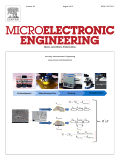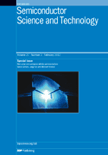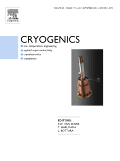
Superconductivity
metrics 2024
Connecting global researchers through superconductivity insights.
Introduction
Superconductivity is a prestigious open-access journal published by Elsevier, dedicated to advancing the field of superconductivity and its applications across various domains. Launched in 2022, this journal has quickly established itself as a pivotal platform for researchers and professionals, earning a distinguished Q1 ranking in multiple categories including Condensed Matter Physics, Electrical and Electronic Engineering, Electronic, Optical and Magnetic Materials, and Energy Engineering and Power Technology. Researchers can access the journal freely, promoting broad dissemination of innovative research findings to a global audience. With a significant focus on multidisciplinary approaches, the journal encourages submissions that explore the theoretical, experimental, and practical aspects of superconductivity. Given its high visibility and the rigorous peer-review process, Superconductivity is an essential resource for those aiming to contribute to the cutting-edge advancements in this transformative field.
Metrics 2024
 -
- 5.60
5.60 5.60
5.60 -
-Metrics History
Rank 2024
IF (Web Of Science)
JCI (Web Of Science)
Quartile History
Similar Journals

MICROELECTRONIC ENGINEERING
Fostering Collaboration in Cutting-Edge Research and DevelopmentMICROELECTRONIC ENGINEERING is an esteemed journal published by Elsevier, focusing on the rapidly evolving fields of microelectronics and nanotechnology. It encompasses a wide array of topics, including atomic and molecular physics, condensed matter physics, and the engineering aspects of electronic, optical, and magnetic materials. With its impressive impact factor and recognition as a Q2 journal in several categories, it provides an invaluable platform for researchers and professionals to disseminate their groundbreaking findings. The journal has been instrumental in advancing our understanding and application of microelectronic technologies since its inception in 1983. Currently ranked highly within various specialized categories in Scopus, MICROELECTRONIC ENGINEERING offers targeted access to cutting-edge research, fostering innovation and collaboration in the world of electronic engineering and materials science. As we look towards the future, with convergence continuing to shape research until 2024, the journal remains a critical resource for those dedicated to pushing the boundaries of knowledge in these dynamic fields.

JOURNAL OF ELECTRONIC MATERIALS
Transforming Ideas into Innovations in Electronic MaterialsWelcome to the Journal of Electronic Materials, a premier publication in the field of materials science. Published by Springer, this esteemed journal has been a beacon for groundbreaking research in electronic, optical, and magnetic materials since its inception in 1972. As an established resource, it boasts a commendable impact factor and categorically ranks in the second quartile (Q2) in key areas such as Condensed Matter Physics and Electrical and Electronic Engineering, as well as holding a respectable third quartile ranking in fields related to Electronic, Optical, and Magnetic Materials and Materials Chemistry. Researchers, professionals, and students can access a wealth of knowledge as we publish original articles, reviews, and cutting-edge research that push the boundaries of science and technology in these critical fields. Stay informed and engaged as we explore advancements that shape the future of electronic materials.

SEMICONDUCTOR SCIENCE AND TECHNOLOGY
Illuminating the future of electronics with groundbreaking insights.Semiconductor Science and Technology is a pivotal journal in the fields of condensed matter physics, electrical and electronic engineering, and materials science, published by IOP Publishing Ltd. With an ISSN of 0268-1242 and an E-ISSN of 1361-6641, this esteemed journal has been disseminating groundbreaking research since 1986 and is set to continue through 2024. Recognized in the latest categorizations, it holds a notable Q2 ranking in Condensed Matter Physics, Electrical and Electronic Engineering, and Materials Chemistry, alongside a Q3 ranking in Electronic, Optical, and Magnetic Materials, highlighting its significant contribution to the advancement of these disciplines. Although it does not operate under an open access model, the journal provides critical access options for researchers and professionals seeking to foster innovation and collaboration within the semiconductor community. As a vital resource, Semiconductor Science and Technology not only supports the dissemination of high-quality research but also serves as a platform for emerging trends and developments that are shaping the future of semiconductor technology.

Crystals
Bridging Theory and Application in Materials ScienceCrystals is a premier open-access journal, published by MDPI since 2011, that focuses on the multidisciplinary fields of chemical engineering, condensed matter physics, inorganic chemistry, and materials science. With its E-ISSN 2073-4352, the journal is headquartered in Switzerland, and actively contributes to the global scientific community by facilitating the dissemination of high-quality research. Ranking in the Q2 quartile across multiple categories, including Chemical Engineering (miscellaneous) and Materials Science (miscellaneous) for 2023, Crystals provides a platform for innovative studies that span from fundamental research to practical applications. The journal's commitment to open access ensures that groundbreaking findings are readily available to researchers, professionals, and students alike, fostering an environment of collaboration and knowledge sharing that is essential in advancing the scientific understanding of crystalline materials.

LOW TEMPERATURE PHYSICS
Navigating the Frontiers of Cryogenic ResearchLOW TEMPERATURE PHYSICS, published by AIP Publishing, is a premier academic journal dedicated to the exploration and dissemination of research in the field of low-temperature physics. With an ISSN of 1063-777X and an E-ISSN of 1090-6517, this journal serves as a vital resource for researchers, professionals, and students eager to delve into the intricacies of thermal phenomena at reduced temperatures. Operating under a structured peer-review process, it presents high-quality, original research articles, reviews, and brief communications, all aimed at advancing our understanding of this specialized domain. Although it does not provide open access, the journal's presence in the Q3 category of Physics and Astronomy (miscellaneous) and its ranking within the 27th percentile reflect its commitment to impactful, cutting-edge research. With a publication timeline spanning from 1997 to 2024, LOW TEMPERATURE PHYSICS remains an essential platform for sharing innovative findings and fostering collaboration among physicists worldwide.

SEMICONDUCTORS
Unveiling the mysteries of magnetic materials.SEMICONDUCTORS, published by PLEIADES PUBLISHING INC, is a prominent journal that provides a platform for researchers and professionals in the fields of Atomic and Molecular Physics, Condensed Matter Physics, and Electronic, Optical and Magnetic Materials. With an ISSN of 1063-7826 and an E-ISSN of 1090-6479, the journal has been diligently disseminating knowledge since its inception in 1996 and continues to pave the way for innovative research until 2024. Although currently unclassified in the Open Access model, its influence is underscored by its rankings in Scopus, where it ranks in the 21st-22nd percentile across critical scientific categories. SEMICONDUCTORS serves as an essential resource for cutting-edge research, fostering a greater understanding of semiconductor materials and their applications, thereby assisting the scientific community in pushing the boundaries of technology and innovation.

npj Quantum Materials
Exploring the Frontiers of Quantum Innovationnpj Quantum Materials is a premier, peer-reviewed academic journal published by NATURE PORTFOLIO, focusing on the transformative field of quantum materials. Launched in 2016, this open-access journal aims to bridge the gap between theoretical advances and experimental discoveries, providing a platform for researchers to share cutting-edge findings in condensed matter physics and materials science. With a prestigious Q1 ranking in both Condensed Matter Physics and Electronic, Optical and Magnetic Materials, it stands out in its field, boasting impressive Scopus rankings—#34 out of 434 in Condensed Matter Physics and #39 out of 284 in Electronic, Optical and Magnetic Materials, putting it in the 92nd and 86th percentiles, respectively. The journal emphasizes collaborative efforts that drive innovation and application in quantum technologies, making it an essential resource for researchers, professionals, and students eager to contribute to this rapidly evolving discipline. Accessible to a global audience, npj Quantum Materials continues to shape the future of quantum research through its high-quality publications and community engagement.

Journal of Superconductivity and Novel Magnetism
Illuminating the Complexities of SuperconductivityJournal of Superconductivity and Novel Magnetism, published by SPRINGER, is a premier venue for research in the dynamic fields of condensed matter physics and materials science. With an ISSN of 1557-1939 and an E-ISSN of 1557-1947, this journal provides an essential platform for disseminating innovative studies examining the complexities of superconductivity and magnetic phenomena. The journal is recognized for its contributions, holding a Q3 quartile ranking in both condensed matter physics and electronic, optical, and magnetic materials as of 2023. With a commitment to rigor and relevance, it features research that breaks new ground in understanding the properties and applications of superconducting materials, aiming to bridge fundamental science with technological advancements. Despite its lack of open access, the journal remains pivotal for researchers, professionals, and students keen to stay abreast of cutting-edge developments in the field, making it an indispensable resource for cultivating knowledge and promoting collaboration.

CRYOGENICS
Connecting Researchers in the Realm of Cryogenics.CRYOGENICS, published by Elsevier Science Ltd, is a highly regarded journal dedicated to the dynamic field of supercooling and cryogenic engineering. With its ISSN 0011-2275 and E-ISSN 1879-2235, the journal features a diverse array of topics encompassing both Materials Science and Physics and Astronomy, as evidenced by its 2023 Q2 ranking in both categories. With a history spanning over six decades, from 1960 to 2024, CRYOGENICS serves as a vital resource for researchers, professionals, and students interested in the latest advancements in cryogenic technologies. Although it operates under a subscription model, the journal is recognized for its scholarly contributions and rigorous peer-review process, effectively disseminating knowledge that informs industry practices and academic research alike. By navigating complex phenomena at low temperatures, CRYOGENICS plays a crucial role in propelling innovations across multiple disciplines, making it an essential publication for anyone engaged in this captivating field.

Journal of Magnetics
Fostering a Community of Magnetic Thought LeadersJournal of Magnetics, published by the Korean Magnetics Society, is an essential resource dedicated to advancing the knowledge and understanding of magnetics across the disciplines of Condensed Matter Physics, Electrical and Electronic Engineering, and Electronic, Optical and Magnetic Materials. With a focus on innovative research and development from 2008 to 2024, this journal serves as a platform for sharing cutting-edge findings and theoretical advancements in the field. Although it currently holds a Q4 ranking in established categories, it is an emerging publication that invites researchers, professionals, and students alike to contribute to and engage with its scientific discourse. Notably, it embraces a community of scholars aiming to bridge the gap between theory and practical applications in magnetics, despite its current Scopus rankings reflecting deeper industry competition. Based in South Korea, the journal operates from its office at Korea Sciences & Technology Center, RM 905, Yeoksam-dong 635-4, Kangnam-ku, Seoul 135-703, South Korea. While it does not provide open access, its commitment to academic rigor promises to elevate its stature in subsequent years, making it a vital publication for those keen on exploring the frontiers of magnetics.